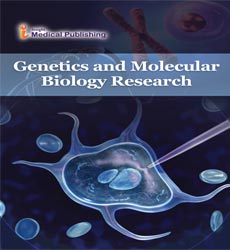One Classic Example Explaining How Alleles Work: ABO - Codominance
Mohammad Akram*
Center for Bio-Technology, Institute of Science & Technology, JNTU University, India
- Corresponding Author:
- Mohammad Akram
Center for Bio-Technology, Institute of Science & Technology, JNTU University, India
E-mail: akramm526@gmail.com
Received Date: May 18, 2021; Accepted Date: May 30, 2021; Published Date: June 16, 2021
Citation: Akram M (2021) Mitochondrial DNA inherited Manifest Risk of Common Diseases: Perspective. Genet Mol Biol Res Vol No: 5 Iss No: 3:50
Copyright: © 2021 Akram M. This is an open-access article distributed under the terms of the Creative Commons Attributions License, which permits unrestricted use, distribution and reproduction in any medium, provided the original author and source are credited.
An allele may be a term coined to explain a selected copy of a gene. Each allele occupies a selected region on the chromosome called a gene locus. The gene’s two alleles are located within the same region in two homologous chromosomes, one inherited from each parent. The alleles could also be dominant or recessive.
The term “phenotype” is employed to explain a clear trait or characteristic. Assuming that the trait is controlled by just one gene, both alleles constitute a genotype. Accordingly, the term genotype is employed to explain an organism’s set of alleles coding for every trait. counting on each allele’s DNA sequence, the genotype is often described as homozygous or heterozygous of a specific gene. Homozygous genotype means the organism’s genome has two identical alleles for a selected gene. meaning both alleles contribute equally to the looks of the trait. Heterozygous genotype, in contrast, contains two different sorts of a specific gene.
There are genes, however, that have quite two alternative allelic forms, they are mentioned as multiple alleles. One classic example explaining how alleles work is that the alleles liable for the flower color garden peas, one among the seven traits studied by Mendel in his experiments that later established the principles of genetics. The color of garden peas flowers is often either purple or white. The gene coding for this trait, liable for producing a purple pigment, is found in two forms, allele for purple color and allele for white color.
Alleles are designated by letters to explain genotypes. Hence, the resulting genotype is written as Pp. Other genotypes which will be found for this trait are PP (Purple flower) and pp (white flower). However, one P allele can produce enough pigment to form the flower purple color this example.
ABO – Codominance
ABO locus has three allelic forms: A, B, O. The genotype of this gene determines the antigens on the red blood cells, hence the blood type phenotype. Both A and B alleles encode for glycosyltransferase that catalyzes the ultimate step within the A and B antigens’ synthesis pathway, while the O allele codes for an inactive version of the enzyme. The enzymes coded by A and B alleles differ in just four amino acids, thanks to several single nucleotide polymorphisms (SNPs) within the ABO gene.
The locus has three alternative alleles, six possible genotypes may result from mating. Two inheritance patterns are often seen in blood groups. Both A and B alleles are dominant once they are found with the O allele. However, if an individual has an AB genotype, both alleles are equally expressed (codominance), leading to a phenotype where both A and B antigens are found on the surface of red blood cells.
Open Access Journals
- Aquaculture & Veterinary Science
- Chemistry & Chemical Sciences
- Clinical Sciences
- Engineering
- General Science
- Genetics & Molecular Biology
- Health Care & Nursing
- Immunology & Microbiology
- Materials Science
- Mathematics & Physics
- Medical Sciences
- Neurology & Psychiatry
- Oncology & Cancer Science
- Pharmaceutical Sciences
